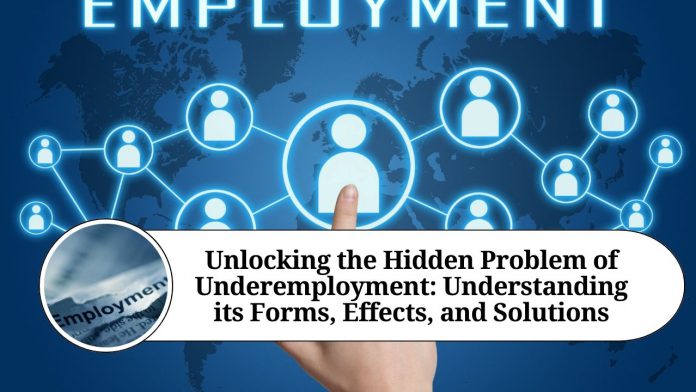INTRODUCTION
Underemployment is a term that refers to a situation where an individual is employed but not to the fullest extent of their abilities, education, or experience. In other words, it is a condition where someone has a job, but that job is not fulfilling their potential or providing them with the desired level of income. Underemployment can take many different forms, and it can occur in various industries and occupations.
Underemployment is also known as “hidden unemployment” because it is not always reflected in official unemployment statistics. According to the International Labour Organization (ILO), underemployment occurs when individuals have a job but still fall short of their desired level of work. The ILO defines underemployment as individuals who work fewer hours than they would like or those who have jobs that do not match their skills and qualifications.
There are several different types of underemployment, each with its own set of characteristics. One form of underemployment is involuntary part-time employment, which occurs when individuals are working part-time hours because they cannot find full-time work. Another type of underemployment is skill mismatch, which happens when an individual’s skills and qualifications are not being fully utilized in their current job. Seasonal or cyclical underemployment is another form, which occurs when individuals are employed during specific seasons, such as tourism or agriculture, and are then out of work for the rest of the year.
Underemployment can have many negative consequences for both individuals and the economy as a whole. For individuals, underemployment can lead to lower job satisfaction, lower earnings, and reduced opportunities for career advancement. It can also impact an individual’s mental health and well-being.
From an economic perspective, underemployment can have significant impacts on productivity, labor force participation, and economic growth. Underutilizing the skills and knowledge of a workforce can lead to lower productivity, which can have an adverse effect on a company’s bottom line. In addition, underemployment can result in individuals leaving the workforce entirely, which can lead to a reduction in labor force participation and a shrinking pool of potential employees.
Underemployment is often associated with precarious employment, which refers to a type of employment that is characterized by uncertainty, instability, and low pay. Precarious employment can take many different forms, including temporary or contract work, gig work, and self-employment. In many cases, individuals who are underemployed are also working in precarious jobs, which can compound the negative effects on their well-being and financial stability.
One of the challenges of addressing underemployment is that it can be difficult to measure and define. Because it is not always reflected in official unemployment statistics, it can be challenging to assess the extent of the problem and develop effective policies and programs to address it. However, there are a variety of tools and methods that can be used to better understand and address underemployment.
For example, policymakers can work to promote education and training programs that help individuals develop the skills and knowledge needed to succeed in the workforce. This can include targeted programs that help individuals develop specific technical skills, as well as broader initiatives that focus on soft skills such as communication, problem-solving, and teamwork.
Another approach to addressing underemployment is to promote policies that support job creation and economic growth. This can include investments in infrastructure, research and development, and entrepreneurship, as well as policies that support small businesses and startups.
Finally
it is important to recognize that underemployment is not just an individual problem, but a societal one. By working to address the root causes of underemployment and promote more inclusive and equitable economic growth, policymakers can help to create a more just and prosperous society for all.
Other Related Blogs: Section 144B Income Tax Act
Frequently Asked Questions (FAQs)
Q: What is underemployment?
A: Underemployment is a condition where an individual is employed but not to the fullest extent of their abilities, education, or experience. In other words, it is a situation where someone has a job, but that job is not fulfilling their potential or providing them with the desired level of income.
Q: How is underemployment different from unemployment?
A: Unemployment refers to a situation where an individual is not employed and actively seeking work. Underemployment, on the other hand, refers to a situation where an individual is employed but not fully utilizing their skills, education, or experience.
Q: What are the different types of underemployment?
A: There are several types of underemployment, including involuntary part-time employment, skill mismatch, and seasonal or cyclical underemployment.
Q: What are the negative effects of underemployment?
A: Underemployment can lead to lower job satisfaction, lower earnings, reduced opportunities for career advancement, and negative impacts on mental health and well-being. It can also have negative impacts on productivity, labor force participation, and economic growth.
Q: How can underemployment be addressed?
A: Policies and programs that promote skills development, training, and job creation can help to reduce the incidence of underemployment and create more opportunities for individuals to succeed in the workforce. Investments in infrastructure, research and development, and entrepreneurship can also support job creation and economic growth. It is important to recognize that underemployment is not just an individual problem, but a societal one, and addressing the root causes of underemployment can help to create a more just and prosperous society for all.




















